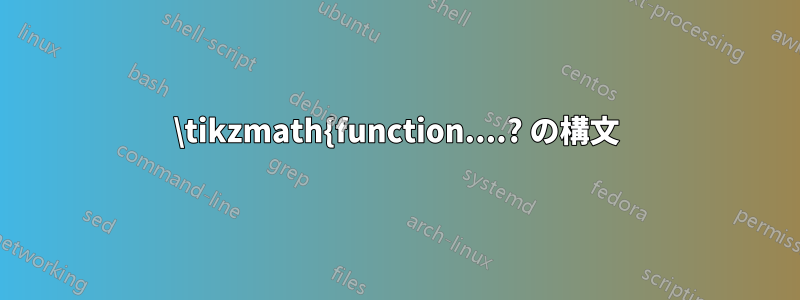
\tikzmathここでの 2 つの関数定義関数の構文の何が問題なのでしょうか?
\documentclass{article}
\usepackage{tikz}
\usetikzlibrary{math}
\tikzmath{function f(\x) { return sin(\x);
}
\begin{document}
\begin{tikzpicture}
\tikzmath{function g(\x) { return cos(\x);
};
\end{tikzpicture}
\end{document}
(どうかお手柔らかに: 私はまだ の初心者ですTikZ!)
答え1
以下に使用例を少し示します。と\tikzmathの間で使用しており、プリアンブルでは使用していないことに注意してください。\begin{document}\end{document}
セミカラムの配置について:マニュアルには次のように記載されていますすべての(tikzmath)ステートメントはセミコロンで終わる必要があります。
\documentclass{article}
\usepackage{tikz}
\usetikzlibrary{math}
\begin{document}
\tikzmath{
function f(\x) {
return sin(\x);
};
real \f;
\f = f(90);
print \f;
print \newline; % new line; the next line begins with no indent
print f(45); % prints "f(45)" verbatim
% No blank line allowed
print \par; % new paragraph; the next line begins with an indent
\f = f(-45);
print \f;
}
Foo
\begin{tikzpicture}
\tikzmath{
function g(\x) {
return cos(\x);
};
real \g;
\g = g(180);
};
\node at (0,0) {\g}; % use \g outside of \tikzmath, in a tikz node
\end{tikzpicture}
\end{document}
編集:ステートメントとは何かについてさらに詳しく。
pgf/TiによるとけZ マニュアルでは、コマンドにはさまざまな種類のステートメントがあります\tikzmath。
- 割り当て(例:
\a = 3 + 4;またはlet \x = 2*3;) - 「型宣言」(
int \i;、real \z;またはcoordinate \c;) - 反復(例
for \n in {1,...,5} {⟨other statements⟩};) - 条件文(例
if ⟨condition⟩ then ⟨statements⟩ else ⟨statements⟩;) - 関数宣言 (例えば
function product(\x,\y) {return \x*\y;};、ここにreturn \x*\y;もステートメントがあり、;最初のコードの 2 番目は関数宣言ステートメントであることに注意してください)
文が中括弧で始まる場合{、閉じ括弧}の後にセミコロンが続く必要があります。
ここではpgf/Tiの例を取り上げます。けZマニュアル、追加コメント付き(セクション58.7パーサー外でのコードの実行(現在のマニュアルの708ページ):
\begin{tikzpicture}
\draw [help lines] grid (3,2); % a common `\draw` TikZ command,
% which ends with a ";"
\tikzmath{ % begin of the \tikzmath command. Not a statemnt
coordinate \c; % a statement
for \x in {0,10,...,360} { % begin of a statement, no ";" here
\c = (1.5cm, 1cm) + (\x:1cm and 0.5cm); % a statement inside
% the for statement
{ \fill (\c) circle [radius=1pt]; }; % a second statement
% inside the for statement.
% In it, a common TikZ command
% (`\draw`) which ends as usual
% by a semi-column.
}; % the end of the for statement. Ended by a semi-column
} % end of \tikzmath command. It's not a statement
\end{tikzpicture}
\draw内のTikzコマンドは中\tikzmath括弧で囲まれているため、;の終わりのの後には、閉じ括弧の後に\drawも があることに注意してください。;



